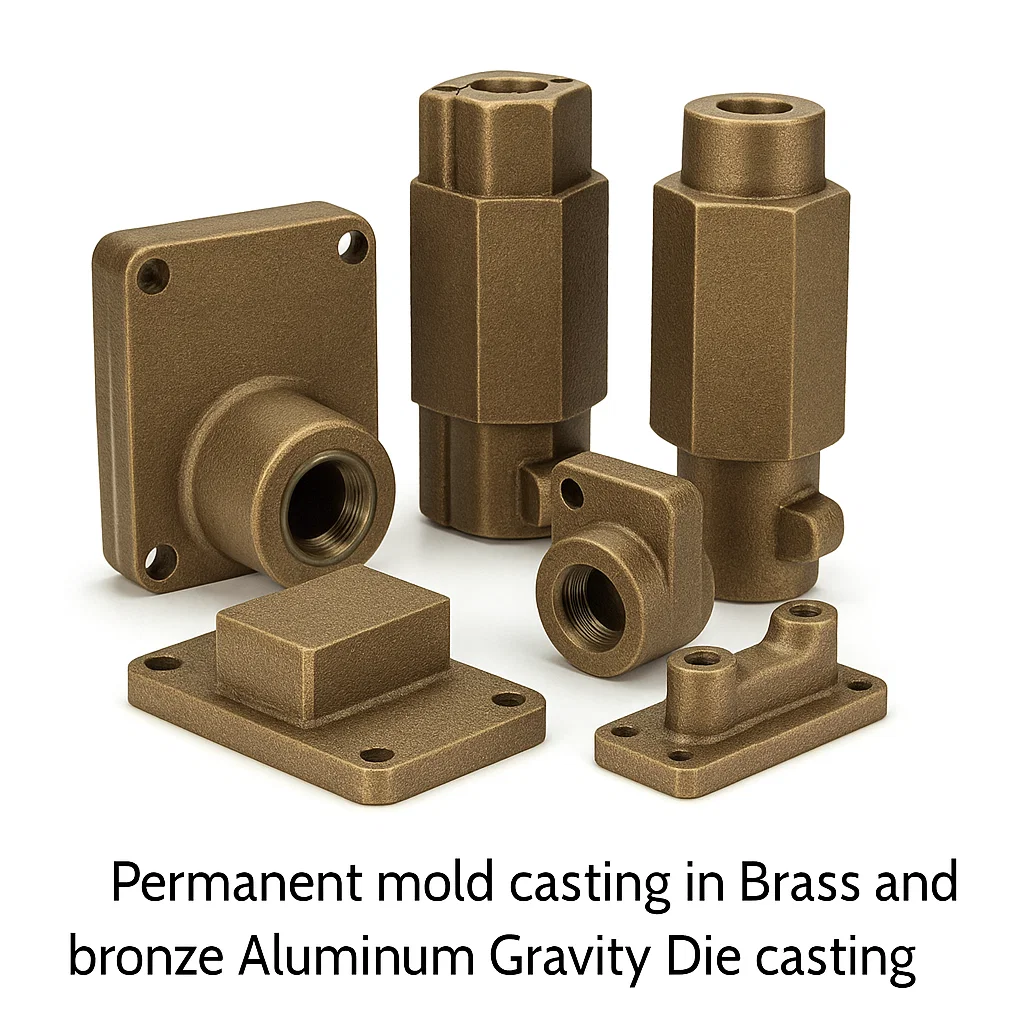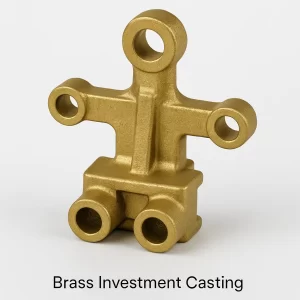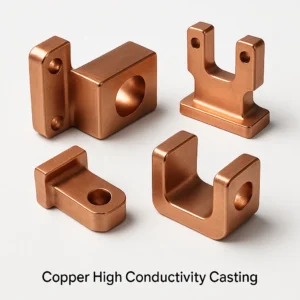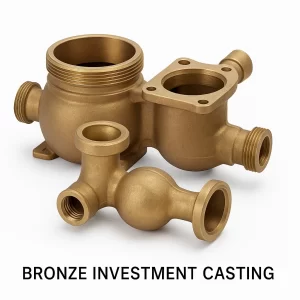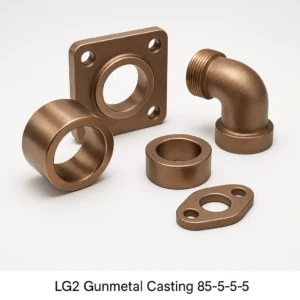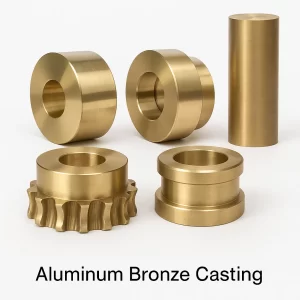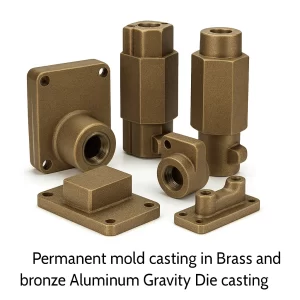Comprehensive Overview of Permanent Mold Brass and Bronze Casting Services
We are one of the leading manufacturers and exporters of Permanent Mold Brass Castings, Permanent Mold Bronze Castings, Gravity Die Cast Brass Components, and Precision Brass Bronze Castings from India. We have been supplying high-quality permanent mold cast brass plumbing fittings, bronze valve bodies, brass pump components, bronze bushings and bearings, brass electrical fittings, bronze marine hardware, brass hydraulic manifolds, and custom brass bronze castings to the world market for many decades. Our state-of-the-art foundry specializes in producing premium brass and bronze castings using advanced permanent mold casting, gravity die casting, tilt pour casting, low-pressure permanent mold casting, CNC machining, heat treatment, and comprehensive quality control systems. With over three decades of global experience in permanent mold brass and bronze casting, we serve diverse industries including plumbing and sanitation (faucet bodies, valve components, pipe fittings, manifolds), industrial valves (ball valve bodies, gate valve bonnets, check valve components), hydraulic and pneumatic systems (manifold blocks, valve bodies, cylinder components), electrical and electronics (connectors, terminals, electrical fittings, bus bars), marine and offshore (pump components, valve bodies, marine hardware, seawater fittings), automotive components (bushings, bearings, transmission parts, brake components), HVAC and refrigeration (valve bodies, fittings, heat exchanger components), and general engineering (gears, bushings, wear plates, structural components). Our expertise encompasses working with various brass and bronze alloys including Yellow Brass C85800 (85-5-5-5 composition, excellent castability), Red Brass C83600 (superior corrosion resistance), Free Cutting Brass C36000 (excellent machinability after casting), Tin Bronze C90700 (marine applications, seawater resistance), Aluminum Bronze C95400 (high strength and corrosion resistance), Phosphor Bronze C90500 (wear resistance for bearings), Silicon Bronze C87300 (architectural and marine), and custom brass bronze alloys meeting specific requirements. We manufacture permanent mold brass and bronze castings ranging from 100 grams to 100 kg with dimensions from 30mm to 800mm, maintaining dimensional accuracy ±0.5-1.5mm, excellent surface finish Ra 3.2-6.3 μm as-cast, wall thickness 3-50mm, superior mechanical properties from directional solidification, compliance with ASTM B584, ASTM B505, ASTM B271, BS 1400, ISO standards, and reliable long-term performance in plumbing, hydraulic, marine, and industrial applications.
Permanent Mold Casting Process for Brass and Bronze
Permanent Mold Casting (also called gravity die casting or gravity permanent mold casting) is a casting process where molten brass or bronze is poured into reusable metal molds (typically cast iron or H13 tool steel) under gravity only, without external pressure. The permanent metal molds provide superior dimensional accuracy, better surface finish, and improved mechanical properties compared to sand casting, making it economical for medium to high production volumes.
Process Description
Mold Preparation: Permanent molds (dies) made from gray cast iron or H13 tool steel designed with CAD/CAM, molds preheated to 250-350°C for brass, 200-300°C for bronze preventing premature solidification, mold release agent (graphite-based) sprayed on cavity surfaces preventing metal sticking, cores inserted for internal cavities (metal cores or sand cores depending on complexity), molds closed and clamped ready for pouring.
Brass/Bronze Melting: Brass or bronze melted in induction or crucible furnaces, yellow brass 950-1000°C, red brass 1000-1050°C, tin bronze 1050-1100°C, aluminum bronze 1100-1150°C, degassing treatment with nitrogen or argon removing hydrogen porosity, fluxing and skimming removing oxides and impurities, melt temperature monitoring and control ±5°C, pouring temperature typically 50-100°C above liquidus temperature.
Pouring: Molten brass/bronze ladled from furnace and poured into mold through pouring basin, gravity flow filling cavity from bottom to top, pouring rate controlled by operator skill preventing turbulence and air entrapment, filling time 3-20 seconds depending on casting size and complexity, gating system designed for smooth flow and proper feeding.
Solidification: Brass/bronze solidifies in metal mold cooling by conduction through mold walls, water cooling channels in mold accelerating heat extraction, solidification time 30 seconds to 8 minutes depending on section thickness and alloy, directional solidification from thin sections toward thick sections and risers, metal mold extracts heat 10-50× faster than sand mold producing finer grain structure and improved mechanical properties.
Ejection and Trimming: Mold opened after solidification (casting temperature 300-400°C), casting ejected using ejector pins or mechanical ejection, gates and risers trimmed by sawing, shearing, or cutting, castings transferred to cooling area, molds cleaned of any metal flash or buildup, molds inspected and prepared for next cycle.
Cycle Time: Typical cycle time 3-12 minutes depending on casting size and complexity, mold preheating, pouring, solidification, ejection, mold preparation for next cycle, production rate 8-80 castings per mold per 8-hour shift, faster production than sand casting (5-30 per shift), economical for volumes 500-100,000+ pieces annually.
Tilt Pour Permanent Mold Casting
Process Variation: Mold mounted on tilting mechanism allowing controlled filling, mold initially horizontal or slightly tilted, molten brass/bronze poured into pouring cup, mold rotated gradually during/after pouring (tilt rate 2-45 degrees per second), controlled filling reduces turbulence and air entrapment, improved casting quality especially thin sections, suitable for complex brass plumbing fittings and valve bodies.
Low-Pressure Permanent Mold Casting
Process Description: Mold positioned above sealed furnace holding molten brass/bronze, compressed air or inert gas (0.2-0.8 bar) applied to furnace chamber, pressure forces molten metal up through riser tube into mold cavity, pressure maintained during solidification ensuring complete filling and feeding, controlled gradual filling reducing defects, excellent for pressure-tight hydraulic components and critical valve bodies.
Advantages: Superior mechanical properties from bottom-up filling and directional solidification, minimal turbulence and oxide inclusions, pressure tightness for hydraulic applications to 350 bar, 15-25% higher material yield versus gravity pour, suitable for thin-wall brass fittings 2-3mm wall thickness.
Brass and Bronze Alloys for Permanent Mold Casting
Yellow Brass C85800 (85-5-5-5 Bronze)
Composition: 85% Cu, 5% Sn, 5% Pb, 5% Zn. Properties: Tensile strength 230-280 MPa, yield strength 95-130 MPa, elongation 18-28%, hardness 60-80 HB, excellent castability and fluidity in permanent molds. Permanent Mold Characteristics: Good fluidity filling thin sections 3-5mm, moderate shrinkage ~1.5%, good surface finish as-cast, economical general-purpose alloy. Applications: Plumbing fittings and valve bodies, general industrial fittings, decorative hardware, pump components, moderate corrosion environments, production volumes 1,000-100,000 annually. Cost: Baseline for brass permanent mold castings.
Red Brass C83600 (SAE 660)
Composition: 85% Cu, 5% Sn, 5% Pb, 5% Zn. Properties: Tensile strength 230-260 MPa, superior corrosion resistance especially marine and potable water, good castability in permanent molds. Permanent Mold Characteristics: Good fluidity, excellent surface finish Ra 3.2-6.3 μm, forms protective patina, suitable for complex geometries. Applications: Marine valve bodies and pump components, plumbing fixtures requiring corrosion resistance, architectural hardware, water meter components, potable water contact applications. Cost: Comparable to yellow brass C85800.
Free Cutting Brass C36000 (CDA 360)
Composition: 61.5% Cu, 35.5% Zn, 3% Pb. Properties: Tensile strength 340-420 MPa, excellent machinability (100% rating), good strength, moderate corrosion resistance. Permanent Mold Characteristics: Good castability, higher shrinkage than tin-bronze-based alloys ~2.0%, requires careful gating design, excellent for components requiring extensive post-cast machining. Applications: Hydraulic valve bodies requiring extensive internal machining, manifold blocks with multiple ports, electrical connector bodies, precision machined components, screw machine products. Cost: Premium 10-20% over C85800 for raw material, but lower total cost when extensive machining required.
Tin Bronze C90700 (Gun Metal)
Composition: 88% Cu, 10% Sn, 2% Zn. Properties: Tensile strength 275-310 MPa, yield strength 130-160 MPa, elongation 20-28%, hardness 70-85 HB, excellent seawater corrosion resistance <0.02 mm/year. Permanent Mold Characteristics: Excellent fluidity and castability, lower shrinkage ~1.3%, good feeding characteristics, superior surface finish, permanent mold enhances mechanical properties versus sand casting. Applications: Marine pump impellers and valve bodies, seawater cooling components, offshore equipment, critical marine fittings requiring 30-50 year service life, naval applications. Cost: Premium 20-35% over yellow brass due to tin content.
Aluminum Bronze C95400
Composition: 85% Cu, 11% Al, 4% Fe. Properties: Tensile strength 620-690 MPa (highest strength), yield strength 275-310 MPa, elongation 12-18%, hardness 170-210 HB, exceptional seawater and cavitation resistance. Permanent Mold Characteristics: Good castability with proper gating, higher pouring temperature 1130-1150°C, requires preheated molds 300-350°C, excellent mechanical properties from permanent mold rapid cooling, heat treatable for enhanced properties. Applications: High-pressure marine valve bodies, pump components for abrasive slurry, offshore platform equipment, high-strength bushings and bearings, mining equipment wear parts. Cost: Premium 40-60% over yellow brass, justified for high-strength and extreme corrosion resistance.
Phosphor Bronze C90500
Composition: 88% Cu, 10% Sn, 0.2% P. Properties: Tensile strength 290-340 MPa, excellent wear and fatigue resistance, superior bearing properties, good corrosion resistance. Permanent Mold Characteristics: Good fluidity, phosphorus addition improves soundness, excellent surface finish, permanent mold produces consistent mechanical properties. Applications: Bearings and bushings for rotating equipment, gears and worm wheels, wear plates and guides, spring components, sliding contact applications, production volumes 500-50,000 pieces. Cost: Similar to tin bronze C90700.
Silicon Bronze C87300
Composition: 96% Cu, 3% Si, 1% other. Properties: Tensile strength 380-480 MPa, excellent corrosion resistance and weldability, superior atmospheric corrosion resistance. Permanent Mold Characteristics: Excellent fluidity for thin sections, good castability, forms protective oxide layer, beautiful reddish-gold appearance. Applications: Marine architectural hardware, corrosion-critical fittings, welded assemblies, high-end decorative components, coastal applications. Cost: Premium 50-70% over yellow brass.
Brass and Bronze Alloy Selection Guide
| Alloy | Tensile Strength | Castability | Corrosion Resistance | Typical Wall Thickness | Applications |
|---|---|---|---|---|---|
| C85800 Yellow Brass | 230-280 MPa | Excellent | Good | 3-40mm | General plumbing, fittings |
| C83600 Red Brass | 230-260 MPa | Excellent | Excellent | 3-40mm | Marine, potable water |
| C36000 Free Cutting | 340-420 MPa | Good | Moderate | 4-50mm | Machined valve bodies |
| C90700 Tin Bronze | 275-310 MPa | Excellent | Excellent (seawater) | 3-40mm | Marine pumps, valves |
| C95400 Aluminum Bronze | 620-690 MPa | Good | Outstanding | 4-60mm | High-pressure marine |
| C90500 Phosphor Bronze | 290-340 MPa | Excellent | Good | 3-40mm | Bearings, gears |
| C87300 Silicon Bronze | 380-480 MPa | Excellent | Excellent | 3-35mm | Architectural, marine |
Advantages of Permanent Mold Casting for Brass and Bronze
Versus Sand Casting
Superior Dimensional Accuracy: Tolerance ±0.5-1.5mm versus ±1.5-3.0mm sand casting, better repeatability part-to-part, permanent mold eliminates sand-related dimensional variations, closer to net shape reducing machining allowances 30-50%.
Better Surface Finish: As-cast surface finish Ra 3.2-6.3 μm versus 12.5-25 μm sand casting (3-5× improvement), smoother surfaces reducing post-casting finishing operations, better appearance for decorative brass hardware, improved sealing surfaces for valves and fittings.
Enhanced Mechanical Properties: Permanent mold faster cooling produces finer grain structure, tensile strength 15-25% higher than equivalent sand casting, improved ductility and toughness, reduced porosity from better feeding and solidification control, superior pressure tightness for hydraulic applications.
Higher Production Rate: 8-80 castings per mold per shift versus 5-30 sand molds per shift, lower labor content per casting, consistent quality reducing inspection time, economical for medium to high volumes 500-100,000 pieces annually.
Lower Cost at Volume: Permanent mold economical at 500+ pieces annually versus sand casting economical for low volumes <500, break-even typically 500-2,000 pieces depending on size and complexity, cost per piece decreases significantly with volume due to mold amortization.
Reduced Material Waste: Cleaner process with less scrap, consistent gating and feeding reducing yield loss, recyclable sprues and gates, environmental benefits from no sand disposal.
Versus Investment Casting (Lost Wax)
Lower Tooling Cost: Permanent mold tooling 40-60% lower cost than investment casting tooling (wax injection dies, shell building equipment), economical for medium to high volumes where investment casting becomes expensive.
Faster Production: Cycle time 3-12 minutes versus 3-10 days for investment casting (shell building time), higher daily production rates, shorter lead times for repeat orders 2-4 weeks versus 4-8 weeks.
Thicker Walls: Permanent mold suitable for wall thickness 3-50mm versus investment casting optimal for 1-25mm, better for structural components and heavy-duty applications.
Larger Castings: Permanent mold economical for larger brass/bronze castings 500g to 100kg versus investment casting optimal for <25kg, suitable for large valve bodies, pump casings, manifold blocks.
Cost Advantage: Permanent mold significantly lower cost per piece for volumes >1,000 pieces, investment casting advantages in extreme complexity, very tight tolerances ±0.1mm, and thin walls <2mm.
Versus High-Pressure Die Casting
Material Flexibility: Permanent mold suitable for high-melting-point copper alloys (brass 950-1050°C, bronze 1050-1150°C), high-pressure die casting limited to lower-melting alloys (zinc, aluminum, magnesium), copper alloys cause excessive die wear in HPDC.
Heat Treatable: Permanent mold brass/bronze castings can be heat treated, stress relieved, or annealed, HPDC aluminum generally not heat treatable due to porosity.
Thicker Sections: Permanent mold minimum wall 3mm versus 1.5-2mm HPDC, suitable for heavier section castings requiring strength.
Lower Porosity: Gravity filling produces lower porosity than high-velocity HPDC injection, better pressure tightness for hydraulic components, suitable for welding and brazing.
Applications by Industry
Plumbing and Sanitation
Valve Bodies: Permanent mold cast ball valve bodies 1/2″ to 4″ sizes, gate valve bonnets and bodies, globe valve components, check valve bodies, butterfly valve bodies, pressure ratings 150-600 PSI (PN10-PN40), red brass C83600 or yellow brass C85800, complex internal cavities for flow control, integrated seat pockets and port connections, production volumes 2,000-100,000 annually, tolerances ±0.8mm as-cast, ±0.1mm machined surfaces.
Plumbing Fittings: Brass tees, elbows, reducers, couplings, unions, manifold blocks, distribution blocks, sizes 1/4″ to 4″, yellow brass C85800 economical general purpose, threaded NPT or BSP connections, socket weld configurations, complex multi-port geometries, surface finish suitable for chrome plating, production volumes 5,000-500,000 pieces annually.
Faucet Components: Faucet body castings, valve cartridge housings, spout bodies, manifold blocks, integrated features reducing assembly operations, dimensional accuracy critical for sealing ±0.3mm, surface finish Ra 3.2 μm for plating, lead-free brass formulations for NSF/ANSI 61 compliance, medium to high production volumes.
Water Meter Components: Meter body castings, strainer bodies, tailpiece assemblies, mounting flanges, red brass C83600 for corrosion resistance and longevity, pressure ratings 150-300 PSI, dimensional accuracy for proper sealing, production volumes 10,000-1,000,000 annually.
Industrial Valves
Ball Valves: Permanent mold cast ball valve bodies and end caps, sizes 1/2″ to 6″, cavity for ball and seats, port configurations (full port, reduced port, multi-port), mounting pads and actuator connections, red brass C83600 or aluminum bronze C95400 for high-pressure, production volumes 1,000-100,000 per year, post-casting CNC machining for precision seats and seals.
Control Valves: Control valve bodies for modulating flow, pressure reducing valve housings, temperature control valve bodies, safety relief valve components, complex internal geometries for flow control, tight tolerances for valve trim fit ±0.1mm machined.
Specialty Valves: Sampling valve bodies, three-way and four-way valve bodies, diverter valve components, vacuum breaker bodies, backflow preventer components, custom valve designs for specific applications.
Hydraulic and Pneumatic Systems
Manifold Blocks: Hydraulic manifold blocks with multiple ports and internal passages, pneumatic distribution manifolds, sizes 50-400mm, pressure ratings 150-350 bar (2000-5000 PSI), free cutting brass C36000 for extensive CNC machining of internal passages, permanent mold provides pressure-tight structure, low-pressure permanent mold casting optimal for critical hydraulic manifolds, production volumes 500-50,000 pieces.
Valve Bodies: Directional control valve bodies, proportional valve housings, flow control valve bodies, pressure control valve components, sizes 10-80mm, integrated port connections and mounting surfaces, aluminum bronze C95400 for high-pressure applications >250 bar.
Cylinder Components: Hydraulic cylinder end caps and bodies, pneumatic cylinder bodies, tie rod designs, integrated port connections, permanent mold produces consistent wall thickness for pressure rating, sizes 25-200mm bore diameter.
Adapter Fittings: High-pressure adapter fittings, transition fittings, union components, complex shapes reducing assembly operations, threaded connections NPT, BSPP, metric, production volumes 2,000-100,000 pieces.
Electrical and Electronics
Electrical Connectors: Brass connector bodies for power distribution, terminal blocks and bus bars, cable lugs and connectors, grounding components, free cutting brass C36000 for post-casting machining, excellent electrical conductivity, production volumes 5,000-500,000 pieces.
Electrical Enclosures: Junction box bodies and covers, conduit fittings and connectors, cable glands and strain reliefs, explosion-proof enclosure components, weather-resistant designs, integrated mounting features.
Bus Bar Components: Permanent mold cast bus bar connectors, distribution blocks, neutral bars, grounding bars, high current capacity, precision tolerances for electrical contact ±0.2mm, surface finish for low contact resistance.
Marine and Offshore
Marine Valve Bodies: Seawater valve bodies for ship cooling systems, fire suppression valve components, ballast system valves, bronze C90700 or aluminum bronze C95400 for seawater resistance, sizes 1″ to 8″, pressure ratings 150-600 PSI, permanent mold superior properties versus sand casting for critical marine service.
Pump Components: Centrifugal pump casings and volutes, pump end covers, impeller hubs, wear rings, bronze C90700 for seawater pumps, aluminum bronze C95400 for abrasive slurry pumps in offshore drilling, permanent mold consistent wall thickness for pressure integrity.
Marine Hardware: Deck fittings and hardware, mooring hardware, propeller shaft components, rudder fittings, bronze alloys for corrosion resistance in marine environment, production volumes 100-10,000 pieces depending on vessel type.
Automotive Components
Bushings and Bearings: Permanent mold cast brass bushings for suspension systems, steering components, transmission parts, phosphor bronze C90500 for wear resistance, aluminum bronze for high-load applications, sizes 20-150mm OD, precise bore dimensions ±0.05mm after machining, production volumes 10,000-1,000,000 annually for automotive OEM.
Transmission Components: Transmission bushing sets, synchronizer components, gear hub castings, brass for self-lubricating properties and compatibility with steel gears, permanent mold consistent quality for automotive standards.
Brake Components: Brass bushings and wear components in brake systems, caliper components, master cylinder components, corrosion resistance and consistent mechanical properties critical.
HVAC and Refrigeration
Valve Bodies: HVAC control valve bodies, refrigeration valve components, expansion valve housings, solenoid valve bodies, sizes 1/4″ to 2″, pressure ratings 20-50 bar, brass C36000 or C85800, production volumes 5,000-500,000 pieces.
Fittings and Adapters: Refrigeration fittings and adapters, manifold blocks for HVAC controls, distribution blocks, threaded and flare connections, production volumes 10,000-1,000,000 pieces for major HVAC manufacturers.
Heat Exchanger Components: Heat exchanger manifolds and headers, connection fittings, distribution blocks, complex internal passages for refrigerant flow, permanent mold pressure tightness critical.
Manufacturing Capabilities and Quality Control
Advanced Permanent Mold Foundry
Mold Design and Manufacturing: In-house mold design using SolidWorks, AutoCAD, casting simulation software (MAGMA, ProCAST) optimizing gating and solidification, CNC machining of mold cavities in gray cast iron (class 30-40) or H13 tool steel, mold surface finishing and treatment, water cooling channel design for controlled heat extraction, mold life 20,000-100,000 castings depending on alloy and design.
Melting Furnaces: Induction melting furnaces 300-3000 kg capacity for brass and bronze, crucible furnaces for smaller batches, precise temperature control ±3°C, degassing systems nitrogen/argon, automated flux addition and skimming systems, melt quality monitoring (spectrometry, temperature, hydrogen content).
Permanent Mold Casting Lines: 20-40 permanent mold casting stations for various sizes 100g to 100kg, manual pouring for low-medium volumes and complex castings, semi-automated pouring systems for higher volumes, tilting mold machines for improved quality, low-pressure permanent mold machines for critical hydraulic components, production capacity 100,000-1,000,000 castings annually depending on size.
Mold Temperature Control: Automated mold preheat systems, temperature monitoring with infrared pyrometers, controlled cooling cycles optimizing productivity and quality, mold release agent spray systems, consistent mold temperature critical for dimensional accuracy and surface finish.
Heat Treatment Facilities
Stress Relief: Heating brass/bronze castings to 250-400°C for 1-4 hours, slow furnace cooling, eliminates residual casting stresses, improves dimensional stability, reduces risk of distortion during machining, standard treatment for precision machined components.
Solution Annealing: Aluminum bronze solution treatment 870-950°C for 2-4 hours, water quench, improves ductility and prepares for aging, applicable to aluminum bronze C95400/C95500 castings.
Tempering: Aluminum bronze tempering 550-650°C for 3-6 hours, air cool, precipitation hardening improving strength and hardness, achieves optimal mechanical properties for structural applications.
Annealing: Full annealing brass/bronze 425-650°C depending on alloy, slow cool, maximum ductility and softness, facilitates secondary forming or machining operations.
CNC Machining Centers
Machining Equipment: 25+ CNC vertical and horizontal machining centers, CNC turning centers and lathes, 5-axis CNC machines for complex surfaces, drilling, boring, threading, milling operations, precision grinding for bearing surfaces.
Capabilities: Machining permanent mold brass/bronze castings to ±0.02-0.05mm tolerances, surface finish Ra 0.4-3.2 μm depending on operation, thread cutting NPT, BSP, metric specifications, complex internal passages and ports, complete machined valve bodies and manifolds ready for assembly.
Tooling: Carbide tooling for brass/bronze machining, optimized cutting parameters for each alloy, tool life monitoring and management, quick-change tooling for efficient production.
Comprehensive Quality Control
Material Verification: Optical emission spectrometry (OES) verifying brass/bronze composition within ASTM B584 specifications ±0.5%, tin, zinc, aluminum, copper content verification, hardness testing Rockwell or Brinell, tensile testing per ASTM B505 on sample castings from production batches.
Dimensional Inspection: CMM (coordinate measuring machine) inspection ±0.003-0.005mm accuracy, precision measuring instruments (micrometers, bore gauges, calipers), thread inspection with Go/No-Go gauges, surface roughness measurement, first article inspection (FAI) complete verification, in-process SPC monitoring critical dimensions.
Non-Destructive Testing: X-ray radiography for critical castings detecting internal porosity and shrinkage per ASTM E155, liquid penetrant testing for surface cracks per ASTM E1417, ultrasonic testing for wall thickness verification, pressure testing (hydrostatic or pneumatic) for pressure-containing components to 1.5-2× working pressure.
Metallurgical Analysis: Microstructure examination verifying grain structure, dendrite arm spacing (DAS) measurement, porosity assessment, inclusion analysis, mechanical property correlation with microstructure.
Pressure Testing: 100% pressure testing of hydraulic manifolds and valve bodies, test pressures 1.5-2× rated working pressure, typical test 300-600 PSI for plumbing, 3000-5000 PSI for hydraulic components, hold time 30-60 seconds minimum, leak detection with soap solution or submerged testing.
Process Control: Statistical process control (SPC) for critical dimensions, control charts (X-bar, R charts), process capability analysis Cpk ≥1.33 target, continuous improvement programs, corrective and preventive actions (CAPA).
Technical Standards and Specifications
ASTM Standards
ASTM B584: Standard specification for copper alloy sand castings for general applications, covers bronze alloys C90700, C95400, C83600, C85800, applicable to permanent mold castings requiring similar properties, composition ±0.5% and mechanical property requirements. ASTM B505: Specification for copper alloy continuous castings, mechanical testing procedures, tensile testing per ASTM B557. ASTM B271: Copper-base alloy centrifugal castings, applicable to centrifugally cast bronze components. ASTM B62: Standard for composition bronze (ounce metal) castings including C83600.
International Standards
BS 1400: British standard for copper alloy castings, LM series designations (LM2, LM6, LM24, LM25), composition and mechanical properties. DIN EN 1982: European standard for copper and copper alloy castings, CC series designations, mandatory for European markets. ISO 1338: Copper-zinc and copper-tin casting alloys, composition and property requirements.
Industry Standards
SAE J461: Copper and copper alloys castings for automotive and industrial applications. ASME B16.18: Cast copper alloy solder joint pressure fittings for plumbing applications. NSF/ANSI 61: Drinking water system components, lead content and leaching requirements for potable water contact, lead-free brass formulations <0.25% Pb.
Quality Management Standards
ISO 9001:2015: Quality management system for manufacturing industries. IATF 16949: Automotive quality management system for automotive tier suppliers. ISO 14001: Environmental management system.
Design Guidelines for Permanent Mold Brass and Bronze Casting
Wall Thickness: Minimum wall 3-5mm for small castings, 4-8mm for medium castings, 5-12mm for large castings ensuring proper feeding and soundness, uniform wall thickness preferred avoiding hot spots, gradual transitions between thick and thin sections, maximum thickness 50mm practical limit for permanent mold.
Draft Angles: Minimum draft 1-3 degrees for external surfaces, 2-5 degrees for internal surfaces and cores, deeper cavities require increased draft, permanent mold requires draft for ejection unlike investment casting.
Tolerances: General tolerance ±0.8-1.5mm for dimensions <100mm as-cast, ±1.5-2.5mm for 100-500mm dimensions, critical dimensions machined to ±0.02-0.1mm, flatness and perpendicularity 0.2-0.5mm achievable, permanent mold 2-3× better accuracy than sand casting.
Cores and Undercuts: Metal cores for simple internal cavities (round holes, simple passages), sand cores for complex internal geometries not achievable with metal cores, external undercuts require sliding cores or split molds increasing tooling cost, core design affects cycle time and cost.
Fillets and Radii: Minimum inside corner radius 1.5-3mm reducing stress concentration, generous fillets at junctions improving strength and feeding, sharp corners cause casting defects (hot tears, shrinkage), smooth transitions preferred.
Surface Finish: As-cast surface finish Ra 3.2-6.3 μm suitable for many applications, machined surfaces Ra 0.8-3.2 μm, sealing surfaces and bearing surfaces require machining to Ra 0.4-1.6 μm, mold surface finish directly affects casting surface (polished mold produces better surface).
Parting Line: Parting line location affects surface finish and dimensional accuracy, critical surfaces located away from parting line where possible, flash at parting line trimmed in secondary operations.
Gating and Feeding: Bottom gating preferred for brass/bronze, risers sized for feeding solidification shrinkage, gating system designed by experienced foundry engineers, gate location considerations for surface finish on critical areas.
Machining Allowance: Typical machining allowance 1-2mm on sealing surfaces, bearing surfaces, threaded connections, 0.5-1.5mm on less critical surfaces, near-net-shape permanent mold reduces machining versus sand casting.
Shrinkage Allowance: Brass/bronze shrinkage 1.3-2.0% depending on alloy (yellow brass ~1.5%, tin bronze ~1.3%, aluminum bronze ~2.0%), mold cavities oversized accounting for shrinkage, critical dimensions verified and adjusted during mold trials.
Why Choose Our Permanent Mold Brass and Bronze Casting Services
Three Decades of Brass and Bronze Casting Excellence
Established 1990: 30+ years producing permanent mold brass and bronze castings for plumbing, hydraulic, marine, industrial customers across 40+ countries. Proven Performance: Delivered 15+ million permanent mold brass/bronze castings, 98% on-time delivery, <0.7% defect rate, major suppliers to plumbing OEMs, hydraulic manufacturers, marine equipment companies. Certifications: ISO 9001:2015 certified quality management, ISO 14001 environmental management, working towards IATF 16949 for automotive applications.
Comprehensive Brass and Bronze Alloy Capabilities
Multiple Alloys: Yellow brass C85800 general purpose, red brass C83600 corrosion resistance, free cutting brass C36000 machinability, tin bronze C90700 marine seawater, aluminum bronze C95400 high-strength marine, phosphor bronze C90500 wear resistance, silicon bronze C87300 architectural. Material Control: Certified suppliers with complete traceability, composition verification ±0.5%, mechanical property testing, heat number tracking from ingot to finished casting.
Advanced Permanent Mold Technology
Modern Equipment: 20-40 permanent mold casting stations, tilting mold machines for complex castings, low-pressure permanent mold machines for critical hydraulic components, automated mold temperature control, consistent quality production. Mold Engineering: In-house mold design and manufacturing, casting simulation optimizing quality and yield, mold library 500+ designs for standard components, custom mold development 6-10 weeks, mold life 20,000-100,000 castings.
Integrated Manufacturing Services
Complete Solution: Permanent mold casting, heat treatment (stress relief, solution annealing, tempering), CNC machining for precision features, pressure testing for hydraulic components, surface finishing and coating, assembly services, one-stop supplier reducing lead times and complexity. Machining: 25+ CNC machines for complete machined valve bodies, manifolds, fittings, tolerances ±0.02-0.05mm, thread cutting NPT/BSP/metric, complete ready-to-assemble components.
Engineering and Technical Support
Design for Manufacturability: DFM review optimizing designs for permanent mold casting, casting simulation (MAGMA, ProCAST) predicting defects and optimizing gating, recommendations for cost reduction 15-25%, tolerance analysis, prototype development 6-8 weeks. Custom Development: Reverse engineering from samples or drawings, 3D CAD modeling, new product development support, valve and manifold design experience, proprietary designs with confidentiality agreements.
Competitive Global Pricing
Cost Advantage: 30-40% lower cost than European and North American foundries, competitive with Chinese foundries offering superior quality systems (ISO 9001), transparent pricing with detailed cost breakdown. Volume Pricing: 500-2,000 pieces: baseline, 2,000-10,000: 15-20% discount, 10,000-50,000: 20-30% discount, >50,000: 30-40% discount, blanket orders: additional 5-10% discount. Break-Even Analysis: Permanent mold economical versus sand casting at 500-2,000 pieces depending on complexity, versus investment casting at 1,000-5,000 pieces, cost per piece significantly lower at high volumes.
Flexible Production Volumes
Medium Volume: Economical permanent mold production 500-10,000 pieces annually, dedicated mold inventory, scheduled production runs, consistent quality. High Volume: Optimized for large orders 10,000-1,000,000 pieces annually, dedicated production cells, automated processes, inventory management programs, JIT delivery available. Prototype to Production: Prototype quantities using existing molds or rapid tooling, bridge production while permanent tooling manufactured, seamless transition to full production.
Global Logistics and Service
Worldwide Export: North America (32%), Europe (30%), Asia-Pacific (18%), Middle East (12%), other (8%), established customers in plumbing, hydraulic, marine, automotive, industrial sectors. Shipping: Air freight expedited 5-7 days, sea freight economical 25-40 days, consolidated shipments, export packaging preventing damage and corrosion. Documentation: Material certificates ASTM/BS/DIN, test reports, dimensional inspection reports, pressure test certificates where applicable, REACH/RoHS compliance declarations, NSF certificates for lead-free brass. Lead Times: Prototype/sample castings 6-8 weeks including mold manufacturing, production tooling 8-12 weeks for new molds, production castings 3-6 weeks for repeat orders, machined components add 2-3 weeks. On-Time Performance: 98% on-time delivery over 5 years.
Frequently Asked Questions
Q1: What are the advantages of permanent mold casting versus sand casting for brass and bronze? Permanent mold casting offers dimensional accuracy ±0.5-1.5mm versus ±1.5-3.0mm sand casting (2× better), surface finish Ra 3.2-6.3 μm versus 12.5-25 μm sand casting (3-5× smoother), 15-25% higher tensile strength from finer grain structure due to faster cooling in metal molds, better repeatability part-to-part eliminating sand-related variations, higher production rate 8-80 castings per mold per shift versus 5-30 sand molds, lower cost per piece for volumes >500 pieces annually. Economical at: 500-100,000 pieces per year. Best for: plumbing valve bodies, hydraulic manifolds, pump components, fittings requiring consistent quality and dimensional accuracy. Permanent mold tooling cost $5,000-$50,000 amortized over production volume.
Q2: Which brass or bronze alloy should I select for my permanent mold casting application? Yellow Brass C85800: General purpose plumbing fittings and valves, economical, good castability, adequate corrosion resistance, baseline cost. Red Brass C83600: Marine valve bodies, potable water applications, superior corrosion resistance, 30-50 year service life, cost similar to yellow brass. Free Cutting Brass C36000: Hydraulic manifolds requiring extensive CNC machining, excellent machinability reducing machining costs 30-50%, cost premium 10-20% for material but lower total cost with machining. Tin Bronze C90700: Marine pump components, seawater valves, excellent seawater resistance, 30-50 year marine service life, cost premium 20-35%. Aluminum Bronze C95400: High-pressure hydraulic valves, offshore equipment, abrasive slurry pumps, highest strength 620 MPa, maximum corrosion resistance, cost premium 40-60%. Consult our engineers with application requirements (pressure, environment, strength, machining, production volume).
Q3: What production volumes make permanent mold casting economical versus other processes? Permanent Mold Economical: 500-100,000 pieces annually. Versus Sand Casting: Break-even typically 500-2,000 pieces depending on size and complexity, permanent mold higher tooling cost ($5,000-$50,000) but lower piece price, sand casting lower tooling ($500-$5,000) but higher piece price and lower quality. Versus Investment Casting: Break-even 1,000-5,000 pieces, permanent mold lower tooling cost and faster production, investment casting advantages in extreme complexity and tight tolerances ±0.1mm. Versus Die Casting: Permanent mold suitable for copper alloys (brass, bronze), die casting limited to lower-melting alloys (zinc, aluminum), different application spaces. Volume Recommendation: <500 pieces: sand or investment casting, 500-10,000: permanent mold, 10,000-1,000,000: permanent mold or die casting (if alloy compatible).
Q4: Can permanent mold brass and bronze castings be pressure tested for hydraulic applications? Yes, permanent mold brass/bronze castings are excellent for pressure-tight hydraulic and pneumatic applications. Pressure Ratings: 150-600 PSI (10-40 bar) for plumbing applications, 2000-5000 PSI (150-350 bar) for hydraulic manifolds and valve bodies. Why Permanent Mold Superior: Faster cooling produces finer grain structure and lower porosity than sand casting, directional solidification from metal mold ensures sound castings, low-pressure permanent mold casting (0.2-0.8 bar pressure during solidification) optimal for pressure-tight components. Testing: 100% hydrostatic or pneumatic testing to 1.5-2× working pressure, typical test 300-600 PSI for plumbing, 3000-5000 PSI for hydraulic, 60-second hold time, leak detection with soap solution or submerged. Alloys: Free cutting brass C36000 or aluminum bronze C95400 for hydraulic manifolds, red brass C83600 for plumbing valves. Applications: Hydraulic valve bodies, manifold blocks, pneumatic valve bodies, high-pressure fittings, pump housings.
Q5: What are typical lead times and minimum order quantities for permanent mold brass and bronze castings? Prototype/Sample Castings: 6-8 weeks including permanent mold design and manufacturing, sample castings, dimensional verification, pressure testing if required, MOQ 25-100 pieces depending on size and complexity (prototype quantities acceptable for development). Production Tooling: 8-12 weeks for new permanent mold tooling design, manufacturing, mold trials, dimensional verification, PPAP if required, MOQ 500-2,000 pieces economical for tooling cost amortization. Production Castings: 3-6 weeks for repeat orders from existing tooling, MOQ 500-5,000 pieces depending on size (larger castings lower MOQ acceptable, smaller castings require higher MOQ for efficiency). Machined Components: Add 2-3 weeks for CNC machining operations after casting. High Volume: 6-10 weeks for initial production >50,000 pieces with optimized tooling and production setup. Expedited Service: 4-6 weeks possible for urgent requirements with surcharge and existing mold availability.
Contact Us Today – Request Quote for Permanent Mold Brass and Bronze Castings
Ready to discuss your permanent mold brass casting, permanent mold bronze casting, or gravity die cast brass bronze components for plumbing valves, hydraulic manifolds, marine components, electrical fittings, or industrial applications?
Request a Quote: Send drawings (PDF, DWG, STEP, IGES), specifications including brass/bronze alloy (C85800/C83600/C36000/C90700/C95400), quantity, pressure rating, machining requirements, application details to sales@jambrass.com for detailed quotation within 48 hours.
Engineering Support: Email technical requirements for design for manufacturability (DFM) review, casting simulation, material selection guidance, cost optimization recommendations.
Call Us: +91-22-43449300 / +91-22-43449323 (Monday-Saturday, 9:00 AM – 6:00 PM IST)
Office Address: 1406, 14th Floor, Dalamal Tower, Nariman Point, Mumbai – 400021, Maharashtra, India
Factory Address: Plot 10B, GIDC Industrial Estate, Shanker Tekari, Udyognagar, Jamnagar, Gujarat, India – 361004
Contact Person: Mr. Mehul Vora
Email: sales@jambrass.com

